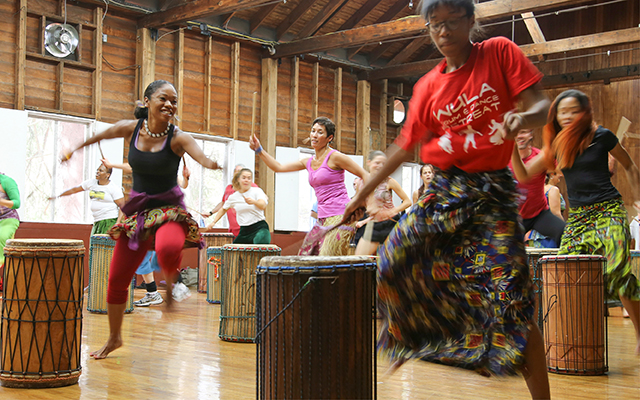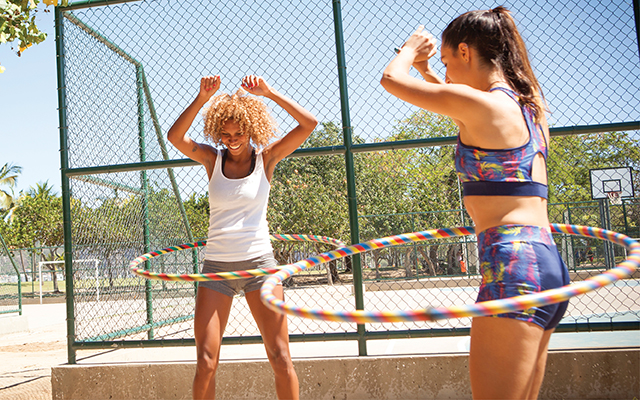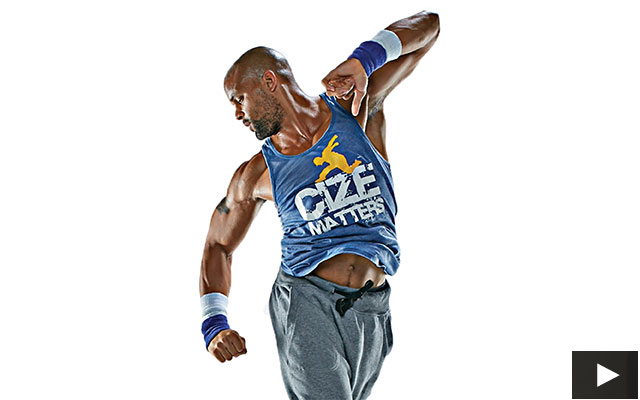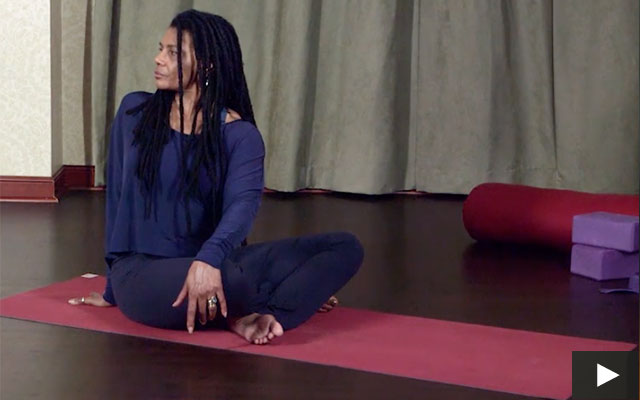I have a tendency to get stuck in my head, which is why I regularly schedule getaways focused on moving my body.
Movement calms me.
So I was surprised recently when my usual approach didn’t seem to be working. On a self-styled getaway in British Columbia, I settled into a familiar routine — sea kayaking, bicycling, massage, lying on a beach. But nothing I did delivered the deep relaxation I needed.
That’s when I called Hollyhock, an educational institute and retreat center on nearby Cortes Island known for its transformative multiday workshops. My last-minute request was granted: There was space for me to have a solo “restorative getaway,” including movement classes, bodywork, kayaking, and food fresh from the garden and sea. At the end of the first night, lounging in a hot tub and gazing at the mountains, I thought I’d found nirvana.
But when I awoke the next morning, I was frustrated to notice my mind was still racing, my body still tense.
As we gathered for breakfast, I struck up a conversation with some people who were taking Hollyhock’s five-day dance retreat and was impressed by how relaxed and alive they seemed. Inspired, I checked the daily schedule and signed up for a 5Rhythms class.
Created by visionary dancer and musician Gabrielle Roth, the 5Rhythms practice launched what’s now known as the conscious-dance movement. More of a movement practice than pure dance, 5Rhythms teaches you to let your body respond naturally to music expressed in five distinct rhythms: flowing, staccato, chaos, lyrical, and stillness.
That one-hour class was a revelation. My shoulders and hips relaxed; my jaw unclenched. I walked away feeling as if I’d been meditating.
Time spent focused on rhythm can do that. “We were in rhythm before we could talk,” says Bettina Rothe, a 5Rhythms retreat leader at Hollyhock. “It connects us to a deeper part of ourselves than language ever could.”
While I felt transformed after one hour in a 5Rhythms class, Rothe notes it often takes students two hours just to quiet their minds enough to really start feeling the benefits of the movement. That’s why she loves the multiday retreats. In a longer program, she says, “you get to remain in the zone.”
Whether you attend a Zumba class at your local health club or treat yourself to a rhythm-inspired getaway, letting go and moving to the beat can transform how you approach everyday life.
Joyful Immersion

Not everyone seeks relaxation through dance. Sanjay Cherubala was first drawn to West African drumming by the energy and enthusiasm it generates.
“I always feel energized after a two-hour class,” says Cherubala, 48, a user-experience manager at a New York City advertising agency. “So when I had an opportunity to take part in a weekend workshop, I had to go.” Since then, Cherubala has traveled several times from his Brooklyn home to the Pocono Mountains of Pennsylvania to attend the four-day Wula Drum and Dance Retreat.
With classes in dance and drumming influenced by West African, Cuban, Brazilian, and Middle Eastern traditions, the retreat is packed with options. Over the weekend, participants might focus on one instrument, like the djembe, or try a variety of drumming or dancing classes. All teachers offer beginner, intermediate, and advanced courses, so it’s easy to hit the right note — or find a new challenge.
There’s no pressure at this retreat, says organizer and drum teacher Michael Markus. “It’s about joyfully immersing yourself in the arts.”
The retreat also offers an opportunity to engage with people from diverse cultures. Classes have included teachers of African, Brazilian, and Caribbean descent as well as participants from China, Japan, and Canada. And all ages are welcome: A 92-year-old woman once attended, and the retreat also offers a children’s program. There’s plenty of time for outdoor activities. “It’s a convivial summer-camp atmosphere,” Cherubala says. “Being in that atmosphere and energy is kind of addictive.”
So addictive, in fact, that he takes this infectious spirit and a sense of momentum home with him. “As I go through the year, my drive to go to weekly classes wanes. After work I’m tired and not motivated,” he says. “But when I go to the retreat, I’m injected with enthusiasm that helps sustain me.”
Wula Drum and Dance Retreat
www.drumanddanceretreat.com
Cost/Amenities: Four days, including classes, lodging, food, and use of all facilities, is $550. Facilities include basic, but comfortable, bunkhouses or camping; private rooms or cabins are available for an additional fee. The camp offers a menu of healthy food, with vegetarian and vegan options.
Chakra Connection
Last spring, stress got the better of Lynn Colangione. “I was losing touch with what I needed to do to stay sane and healthy,” she recalls. “I needed a real retreat to unplug, reconnect with what’s important, and get quiet inside.”
A few years earlier, Colangione, 48, a mom and financial manager for a small, family-owned chain of hardware stores in West Newton, Mass., had traveled to Kripalu Center for Yoga & Health, two hours away in Stockbridge, where she’d enjoyed Jurian Hughes’s standalone yoga dance class. This time she registered for Hughes’s three-day chakra yoga, dance, and meditation retreat.
Hughes leads participants through yoga, dance, meditation, visualization, chanting, and affirmations — all of which help balance the chakras, the body’s seven energy centers. “They are an ancient map of the body that helps us understand how the physical, emotional, and mental bodies work in relationship to each other,” Hughes explains. “When energy flows through all seven freely, we tend to feel good and be happier.”
The chakras are also a map of the endocrine system, so balancing them nourishes the adrenals, reproductive system, blood-sugar regulation, immune system, and the thyroid, pineal, and pituitary glands.
“This retreat is a great stress reducer,” says Hughes. “It also produces a lot of joy.” It includes cardio for the heart and lungs, work on flexibility and strengthening, and a moderate level of yoga. “We have a good sweat, as well as deep relaxation.”
Great for people who want to dance and experience reconnection with their bodies, the program has attracted participants as young as 17 and as old as 70-something.
After her weekend retreat, Colangione left feeling more profoundly connected to her body. “The whole experience brought a deep sense of peace, joyfulness, and openness,” she says. “I left recommitted to doing things to care for myself.”
Kripalu Center for Yoga & Health
www.kripalu.org
Cost/Amenities: Tuition is $225. Nourishing food and lodging — ranging from simple private rooms to shared bunkrooms — run from $198 to $398.
Hoop It Up

Caroline Sánchez, RN, 36, an oncology nurse in La Jolla, Calif., knows a lot about burnout; she wrote her master’s thesis on compassion fatigue. Her antidote, however, is slightly unconventional.
On a whim several years ago, Sánchez started playing around with a Hula-Hoop and quickly felt its soothing and energizing effects. By 2014 she was teaching hoop dancing, which expands on basic Hula-Hoop tricks to foster unique, rhythmic-embodied movement expression.
When she attended her first Hoop Camp, an annual gathering of “hoopers” in Santa Cruz, Calif., Sánchez fell in love with the women she met, including sisters Laura Anne and Luna Brie Blakeman. Inspired, Sánchez decided to join the sisters at their weeklong hooping retreat, In-Depth Hawaii Hoopdance.
Held at Kalani, an educational retreat center on the Big Island of Hawaii, set between the jungle and cliffs overlooking the Pacific, In-Depth is designed for intermediate and advanced hoopers.
Each day begins with an optional gentle-yoga class, because it’s a terrific prehooping warm-up. Workshops focus on helping experienced hoopers expand their repertoire of tricks and techniques. “They’re not intimidating at all,” says Sánchez of the workshop leaders. “They are joy advocates and joy leaders in the truest sense!”
Evenings include wholesome meals, pool time, engaging conversation, and plenty of opportunities to watch the sunset from the cliffs.
In addition to building connections with others, hooping helps alleviate self-consciousness and depression, says Luna Brie. “You can’t not smile and Hula-Hoop at the same time.”
Sánchez returned home with a greater appreciation for the power of play to release stress and replenish joy. “It shifts things for you and makes you see things a bit brighter,” she says.
In-Depth Hawaii Hoopdance
www.therhythmway.com
Cost/Amenities: Including lodging, which is comfortable and basic, with shared central bath areas, the retreat costs between $1,350 and $1,900; participation is limited to 35 students.




This Post Has 0 Comments